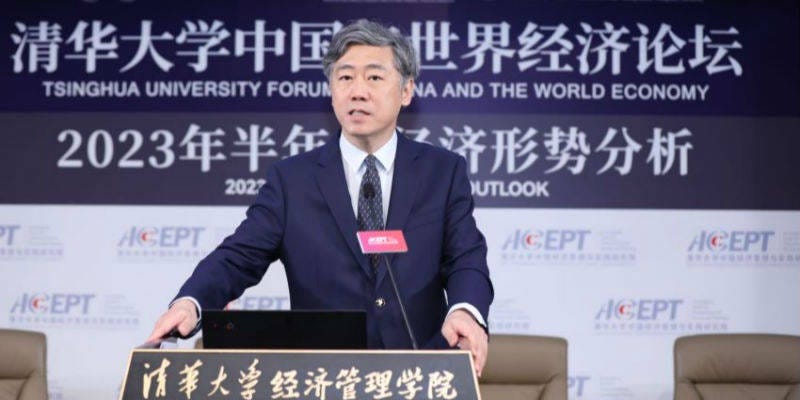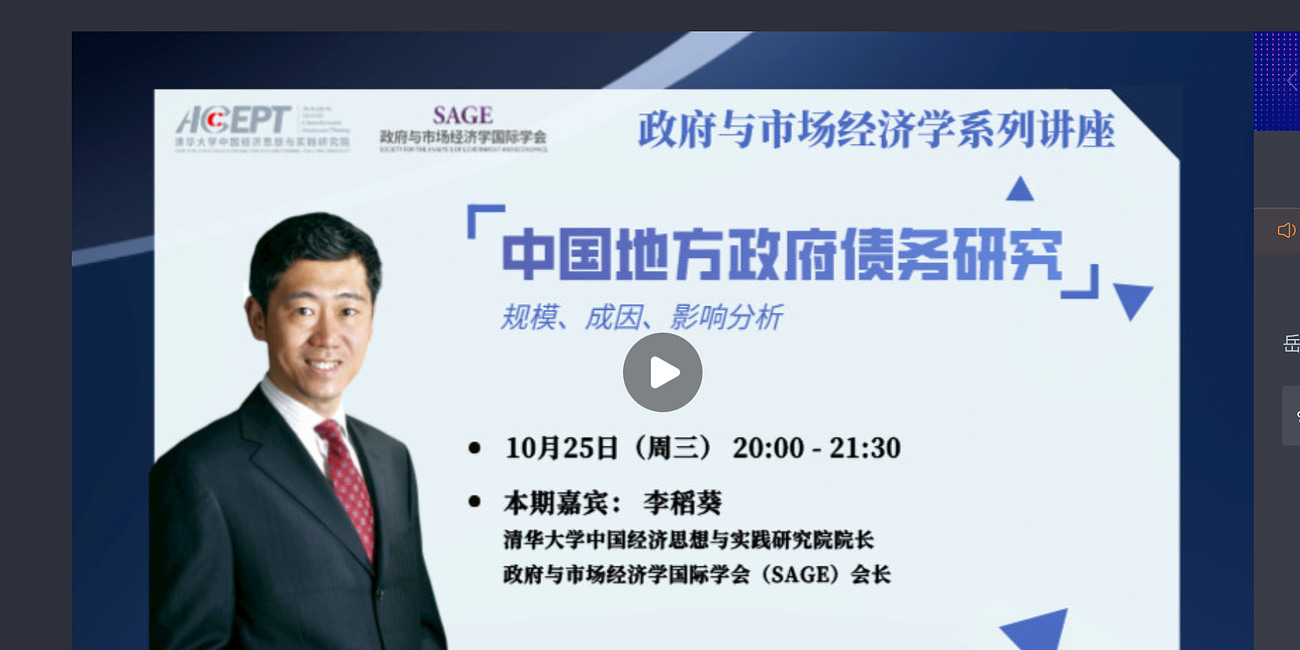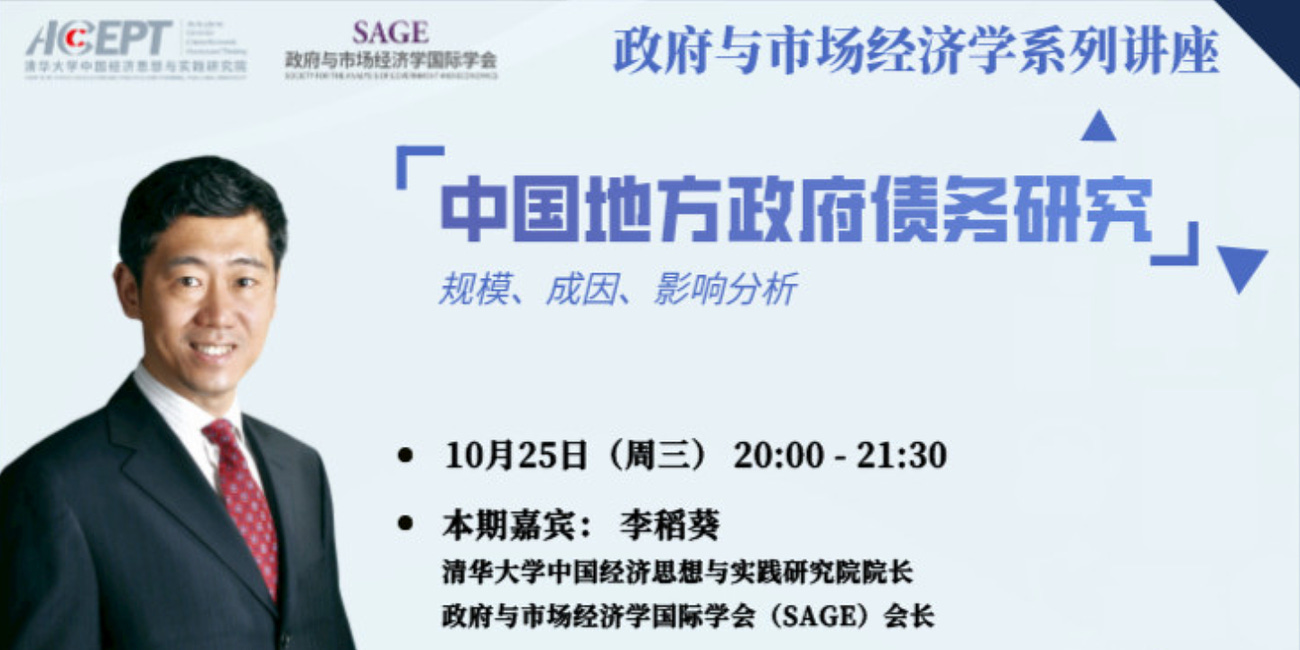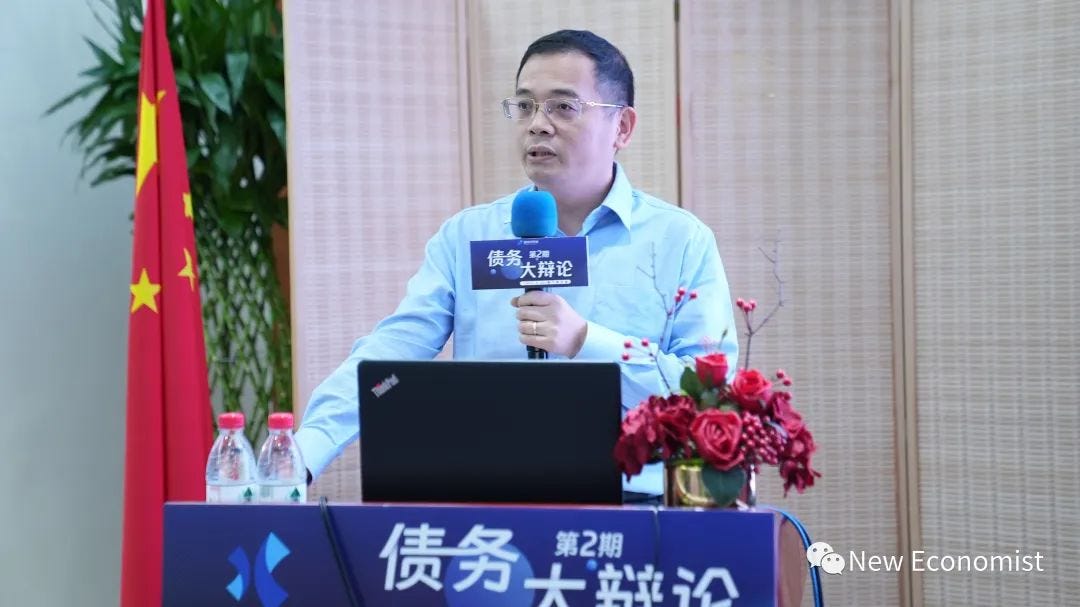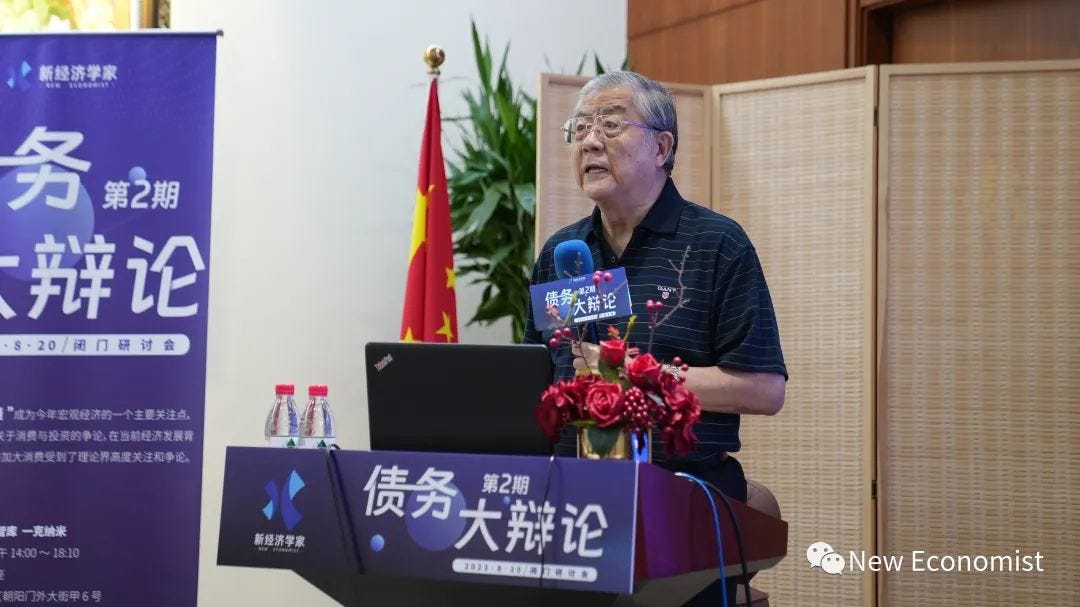Part III of David Daokui Li: local government debt in China driven by central's GDP requirement and prevalent short-term focus
A 10% increase in debt correlates with a 0.1% reduction in GDP growth, discovered Prof. Li, who advocated for central government intervention and liquidation of local government assets.
Hi, this is Jia Yuxuan from Beijing, coming to the third and final part of Prof. David Daokui Li's lecture on the scale and dimensions of China's local government debt.
In the first part of the study by Prof. Li and Zhang He, it was reveiled that China’s local government debt in 2020 was around 90 trillion yuan, 50% higher than World Bank and IMF estimates. In the second part, the cause of this substantial gap in debt scale was identified as a "nested structure", where local governments establish entities to secure loans, and these entities, in turn, leverage those borrowed funds to acquire further financing for their subsidiaries.
In today's section, Prof. Li examines the underlying motivation and institutional factors driving local governments' excessive borrowing, and its economic impact on GDP growth, fixed asset investment, and total factor productivity, etc.:
The traditional belief that local government debt in China stems primarily from the strategy of leveraging debt for growth is overly simplistic. Rather, this high debt level is attributable to a combination of an excessive focus on GDP growth ("GDP obsession") and a short-term approach to fiscal policy ("short-termism").
Local governments, aiming to fulfill the central government's requirements for maintaining stable economic growth and mitigating the impact of external shocks, frequently resort to substantial short-term borrowing. This practice is a key systemic and institutional factor driving the elevated local government debt levels in China.
Contrary to the assumption that high borrowing by local governments leads to excessive investment, it often results in inadequate investment. This is because excessive short-term borrowing hampers the government's debt repayment capacity, subsequently diminishing its ability to fund future investments and impeding local growth.
Prof. Li thus recommends three approaches to managing local government debt:
The central government must take over part of the local debt and convert it into national debt.
Convert short-term local debt into long-term debt.
Local governments should liquidate some of their assets to generate cash and alleviate part of their debt.
Prof. David Daokui Li is the Mansfield Freeman Chair Professor of the Department of Finance of the School of Economics and Management of Tsinghua University. He is also the director of the Academic Center for Chinese Economic Practice and Thinking (ACCEPT), Tsinghua University.
The following article is the third and final part of the translation of Prof. Li's lecture at the 8th session of the "Government and Market Economics Series," an event organized by ACCEPT at Tsinghua University on Oct. 25. These transcripts were originally compiled and published by the New Economist WeChat account.
The full video of Li's lecture is still available at this link, though it requires registration with the platform.
Please note that the original lecture includes extensive mathematical calculations that have been largely omitted in the translation for brevity.
Economic Explanation of Local Government Borrowing Behavior
To provide an economic explanation for local government borrowing behavior, it is essential understand the incentives and actions of the government. Given China's present socio-economic circumstances, the government is compelled to prioritize economic development, with a particular emphasis on GDP growth and short-term economic expansion. As a result, it often pursues growth by leveraging debt.
It's important to recognize that such excessive borrowing doesn't automatically result in overinvestment. The true social impact of these investments, whether beneficial or detrimental, is a critical factor in this assessment. Evaluating whether there's overinvestment requires analyzing the returns on these investments, rather than merely considering the volume of borrowing.
Our conclusion is that while excessive borrowing by local governments may appear as a one-shot game to secure substantial funds, it has longer-term implications. Specifically, heavy borrowing in the initial phase can restrict borrowing options in the subsequent phase. Over these two periods, the overall financial capacity of the government is likely to be compromised. This forms the essence of our argument, where we use a simple two-period game model to demonstrate the impact of excessive borrowing on long-term financial sustainability.
Assumption is the fundamental element in every game. So here's a breakdown of our assumptions:
d₁represents infrastructure debt incurred by local governments during the first period, which directly contributes to GDP growth and incentivizes private sector production.
k₁represents private enterprises' investments that follows the local government's infrastructure debt.
The purpose of d₁is to trigger k₁.
At the conclusion of the initial period, private enterprises yield an output represented by f(d₁,k₁), which is essentially equivalent to GDP.
Subsequently, local governments generate tax revenues amounting to 𝜏f(d₁,k₁).
Towards the end of the first period, local governments are confronted with debt repayment obligations totaling Rd₁.
However, a challenge arises if, unfortunately, the second period begins without a substantial influx of "k₁." In other words, the local government's efforts to attract capital and investments may not have yielded the desired results. Consequently, GDP doesn't rise as anticipated, and the tax revenue may fall short of covering the interest expenses. Consequently, local governments might encounter difficulties in borrowing more, potentially leading to a debt crisis in the second period.
Of course, it's important to note that our core assumption is somewhat extreme, idealized, and simplified. We assume that:
When 𝜏f(d₁,k₁) − Rd₁> 0, the first-period debt is repaid, enabling local governments to secure second-period debt, denoted as d₂, followed by private enterprise investments captured as k₂.
When 𝜏f(d₁,k₁) − Rd₁< 0, local governments experience default and are unable to acquire additional debt. Consequently, d₂= 0, k₂= 0. The game becomes a gamble.
Conclusion: prudent decision-making in the first period, rather than taking risks, is advisable for local governments.
[Prof. David Daokui Li then explained how he and his team arrived at the functions for government objectives in the first and second periods. Due to space constraints, the details of this explanation are omitted for brevity. However, here is a brief overview of the functions proposed by Prof. Li:]
The second-period objective is represented as
in which the critical value k₂is a function of d₂and satisfies this equation:
The first-period objective is represented as
in which the critical value k₁is a function of d₁and satisfies this equation:
Impact of local government debt on economic development
[Again, the more technical elements of this section is omitted for brevity.]
Our empirical study examined the influence of local government debt on future economic growth in China. We gathered provincial-level panel data spanning 30 provinces and municipalities from 2013 to 2019, employing databases such as WIND for analysis. The study involved two regression analyses, focusing on the following dependent variables:
GDP Growth Rate
Fixed Asset Investment Growth Rate
Infrastructure Investment Growth Rate
Manufacturing Investment Growth Rate
Total Factor Productivity (TFP) Growth Rate
These were evaluated against the core explanatory variable: the Local Government Debt-to-GDP Ratio, as calculated in this study, including its squared term.
[For those who might be interested, the regression models are as follows, with controlled variables represented as z, i, and t.]
The findings indicate that the relationship between local government debt and economic development is not U-shaped; rather, it consistently demonstrates a negative impact across various economic growth metrics. The higher the debt level, the more it negatively affects the above dependent variables.
To address potential reverse causality concerns, we explored whether GDP growth rate might inversely affect debt levels. Utilizing the average growth rate of the subsequent three years as the dependent variable, our analysis still showed a negative correlation.
Specifically, an increase in debt by 10% correlates with a 0.1% decrease in the GDP growth rate and a 0.7% reduction in TFP over the same period, reinforcing the negative relationship between local government debt and economic growth.
Summary of three core findings
China's local debt has reached an exceedingly high level, comprising approximately 90% of GDP, which makes it difficult for local governments to meet their interest obligations. Without intervention, the local debt situation is unsustainable, leading to a cycle of acquiring new debt to repay existing obligations.
Excessive local debt issuance may be due to an overemphasis on GDP and short-term GDP growth – a combination of short-termism and GDP-centered policies.
High level of local government debt is presently suppressing fixed asset investment, TFP growth, and overall economic growth.
How should local debt be managed?
After discussing this, let me take a few minutes to talk about our institute's recent thoughts on how to handle local government debt in China.
We propose three principles:
First, the central government must intervene, taking over part of the local debt and converting it into national debt. This is because, during the process of accumulating debt, local governments have, to some extent, aimed to fulfill the central government's requirements for maintaining stable economic growth and mitigating the impact of external shocks. For instance, one potential solution could involve the central government assuming control of a portion of the local debt, perhaps around 20%.
China's central government has the capacity to incur debt, and its current asset portfolio probably stands as one of the strongest among sovereign governments worldwide. As I mentioned earlier, these assets include major banks, telecommunications operators, and more. When the central government increases its debt issuance, many foreign entities would seek to purchase these bonds in order to hold assets denominated in RMB. For instance, companies like Saudi Arabian oil companies and Russian oil companies, who sell oil to China and receive RMB in return, would desire to engage in RMB settlements. They may temporarily choose not to invest in Chinese cars or refrigerators but opt to purchase China's sovereign bonds as an entirely feasible alternative.
Second, convert short-term local debt into long-term debt. Many of the current short-term debts, often with durations of 5 or 10 years (and some with even shorter durations when borrowed from banks), were obtained to finance short-term urban revitalization and infrastructure development projects. Nonetheless, the advantages they generate will extend and benefit numerous generations in the future. In that case, such beneficial long-term projects shouldn't be constrained by short-term repayment demands. These debts should be extended to 20 or 30 years, with central government guarantees, but with a commitment from local governments to repay.
Third, local governments should liquidate some of their assets to generate cash and alleviate part of their debt. Of course, the circumstances of each local government vary, and there is no one-size-fits-all solution. We recommend initiating a debt resolution mechanism customized for each city, one that can flexibly adapt to the local context and conditions. For instance, I recently proposed in Chongqing the establishment of a Southwest Local Government Debt Restructuring Center in its financial hub, Jiangbeizui, to focus on this issue.
In conclusion, although China's overall local debt is substantial, it does not present a systemic risk or cause for national economic panic. Viable solutions are available, but they necessitate a comprehensive, step-by-step approach. We need to treat debt resolution as a long-term endeavor and efforts must begin now without delay.
To give an analogy, China's local debt resembles a scenario where a family seizes the opportunity to purchase a property at a relatively low price. They acquire this property with the intention of providing housing for their future generations. All in all, these houses they've acquired serve a useful purpose. However, they find themselves unable to repay the short-term debts promptly. What's the solution? They must extend the repayment period for the debt, seek assistance from other families' parents, and convert short-term debt into long-term debt. Their hope is that their descendants can gradually repay the debt over time when they eventually reside in these well-appointed houses. I present this example to illustrate the situation.
Check out the series of newsletters from The East is Read focusing on China's local government debt situation, with the first two parts of David Daokui Li and more!
— Jia Yuxuan




